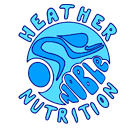Under-fuelling is no joke. When an athlete does not consume enough calories for a prolonged period of time to support their energy demands for training and other resting metabolic functions, they are at risk for developing a syndrome called RED-S (Relative Energy Deficiency in Sport).
What is RED-S?
The commonly known Female Athlete Triad (shown in Fig.1 below in red) was thought to be a phenomenon that occurred exclusively in women. It included a combination of:
(1) disordered eating or low energy availability, leading to
(2) decreased estrogen production and irregular menstrual cycles, resulting in
(3) decreased bone health and bone mineral density (BMD).
However, recent research has found that this phenomenon was not simply a triad, but rather a very complex and serious syndrome that can lead to disturbances over the entire body. Additionally, RED-S has the potential for short and long-term complications on athletic performance and overall health for both men and women. The figures below show some of the various health and athletic performance (anaerobic and aerobic) consequences of RED-S.


Both images adapted from Costantini NW. Medical concerns of the dancer. Book of Abstracts, XXVII FIMS World Congress of Sports Medicine, Budapest, Hungary, 2002:151. NW (2002).
Inadequate caloric intake is not limited to disordered eating practices. Whether you are intentionally restricting your food intake or not, RED-S can still develop. It can in fact be very challenging to eat enough on a daily basis for athletes with very high energy demands, some requiring from 3,000-8,000 calories/day.
Health and Performance Consequences of RED-S:
When your body is in an energy deficient state, it redistributes energy to prioritize more essential functions (such as fuelling muscles during physical activity). The following consequences occur as a result of inadequate caloric intake:
- Decreased metabolism. The number of calories a day your body needs at rest (Resting Metabolic Rate) will decrease as a way to conserve energy.
- Compromised immune function. The body becomes more susceptible to illnesses and viruses as it does not have enough energy to build a strong immune system.
- Decreased bone health. The body produces less estrogen, which leads to a decrease in calcium uptake into the blood and bones in men and women. This can lead to low bone mineral density (BMD), resulting in osteopenia, and eventually osteoporosis. Low BMD has also been associated with decreased testosterone levels in male athletes due to energy deficiency. This leaves athletes at an increased risk for stress fractures and recurring injuries.
- Menstrual dysfunction. The body becomes unable to produce sufficient hormones needed for reproductive function (primarily estrogen), which can lead to irregular menstrual cycles, amenorrhea (3 or more consecutive missed periods, not due to pregnancy) or a delay in menarche (first menstrual period). Long-term reproductive consequences from RED-S for both men and women remain unknown.
- Gastrointestinal issues. The amount of energy used for overall digestion is reduced, which can lead to prolonged gastrointestinal symptoms including: gas, bloating, diarrhea, nausea, constipation, etc.
- Hematological abnormalities. Individuals are at a higher risk for developing vitamin and mineral deficiencies, especially iron due to its naturally low absorption and bioavailability. Low iron intake can lead to Iron Deficiency Anemia (IDA), which can significantly impact athletic performance through a reduction in the body’s ability to deliver oxygen to working muscles and tissues.
- Compromised growth and development. The body produces a reduced amount of growth hormone and other substrates required for proper growth and development. These are especially important in younger athletes. Glycogen storage and protein synthesis are also negatively impacted, both in which are key for optimal athletic performance.
- Compromised cardiovascular health. Relative energy deficiency can lead to abnormal lipid values and narrowing of blood vessels, which increases the risk for cardiovascular problems.
- Psychological stress. Psychological stress (including anxiety and/or depression) can either contribute to the onset of RED-S or occur as a result of RED-S. Irregular menstrual cycles and/or amenorrhea can also have a significant impact on anxiety and create an altered perception of self. RED-S can also cause irritability and decreased mood, therefore, negatively affect concentration, coordination, judgement and overall training response.
Who is at Risk?
- Athletes in sports where a low body weight or leanness is desirable for performance, aesthetics, or to meet a weight-class category.
- Endurance athletes (cross-country runners, cyclists, triathletes) due to extremely high energy needs.
- Female athletes (of any-level) who has not had their first period by age 16 or who has missed 3 consecutive menstrual cycles (not due to pregnancy).
- Excessive dieting, significant weight loss, preoccupation with weight/caloric intake, frequent weight cycling, or low body mass index (BMI).
- Internal or external pressure to lose weight (from themselves, coaches, family, sporting environment and culture etc.)
Signs and Symptoms
- Amenorrhea or irregular menstrual function
- Disordered eating
- Signs of overtraining or overreaching
- Hypothermia (cold intolerance)
- Gastrointestinal problems
- Hair loss
- Recurring and lingering injuries, stress fractures, or illnesses
- Significant weight loss
- Cardiac abnormalities
- Iron deficiency anemia
- Generalized fatigue
- Anxiety or depression
A few reminders before you go:
- Restricting your caloric intake can have serious consequences to your athletic performance and overall health.
- Do not leave RED-S untreated. If you are experiencing any of the signs and symptoms above and have concerns, please contact your Medical Doctor, a Registered Dietitian or a Health Care professional.
- Remember, food is your ultimate performance enhancer!
Written by: Heather Noble, RD
For more information, please read:




